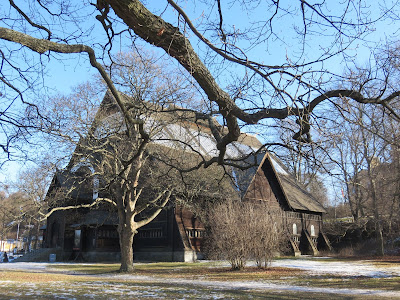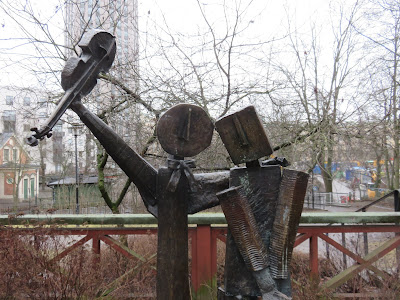Even at a great workplace frustration seeps in once in a while. Not everything always goes as planned, and sometimes things do unfold as planned but it just turns out the plan wasn't all that great. The good thing about being responsible for your own schedule means you usually can step away from tasks when agitation gets a hold of you. Still, it did take me a while to realise this, and it took me even longer to actually put it into practice.
On good days I enjoy hearing the Swedish chattering around me and I take pleasure in using my limited vocabulary to decipher the topic of the conversation. On bad days it makes me feel like an outsider, lonely and a bit unwanted. Almost everyone in Stockholm speaks fluent English and they are terribly helpful, so it's not like I actually ever encounter real problems. But still, not speaking the language makes me far more vulnerable than I thought it would. I can't imagine how horribly disconnected people who can't resort to any mutual language must feel when they arrive in a foreign country.
Frustrations come, and they also go again. There is usually always someone around who can help. (Except for the IT-guy. He just mysteriously appears and then dissolves again and nobody seems to know where he actually comes from.) I just need to remember to open my mouth and actually ask for assistance, but I have already gotten a little better at that.
But then the day came when no amount of venting to my dear cohabitants of our island-of-desks could prevent a mental breakdown. Ironically, but perhaps typically for me, it was about the lamest tasks of all: printing. It seemed to be the simplest job I had gotten my entire internship - print out emails with all their attachments. Sure, there were a lot of emails, but it was still just a matter of clicking one button a few 100 times. How foolish I was.

See, not everyone thinks ahead when they send mails with attachments. Oh, the exotic file types I have seen! And even pdf's don't always work along... Pressing one button quickly turned into manually opening almost every attachment, battling faulty files and soothing an overheated printer. The hours went by, lunchtime was approaching fast and I still was nowhere near the end. A new error message cheerfully popped up on my computer screen and it was immediately followed by an unannounced tear rolling down my cheek. And another one. I tried to wipe them off quickly and tell myself I was being stupid, but before I knew it I was having a full-blown sobbing session in the middle of the office.
My sweet colleagues quickly ganged up on me with comforting words, hugs, appropriate hot beverages, pieces of orange and cardamom buns. For a long while I was only able to answer them with snorting noises, wheezes and weird whiny sounds. There I was, the globetrotting adventurer, bravely travelling all alone to an unknown city in an unknown country with a language, a currency and pastries I was not familiar with, working day in day out alongside some of the most inspiring people I have ever met - and now I was blowing snot in their direction over the most stupid thing ever. This was it. I would now forever be known at Bonniers Konsthall as that failing intern who cried because she couldn't handle a few prints.


Katya was notified of her malfunctioning intern and took me into her office to calm me down. As I tried to explain myself I felt so ashamed. But it started to dawn on me that I seemed to be the only one who thought my breakdown was ridiculous. No one was laughing or rolling their eyes. Katya said: "It's not worth crying over. It's only paper. Nobody is going to die if printing them takes a bit longer. If this doesn't work we just need to figure out another method." The words echoed in my head and slowly started to make sense.
It's only paper.
Nobody is going to die.
It is only paper.
It's only paper.
It's only paper.
It's only paper.
It took me some time to pull myself together and I didn't go anywhere near the printer again that day. Katya suggested a new plan of action which required less printing and gave me more time. I began to feel a little less ashamed of breaking down over some unknown person carelessly sending in both Apple and PC-only files in one and the same e-mail. Instead, I got a bit angry at myself for not speaking up when I realised I couldn't print it all in time. The combination of stress, lingering sadness over leaving soon and the shame of not being able to handle a simple job probably stopped me from doing the most logical thing. But still, I could have and I should have just opened my mouth.


This was probably the most horrid day of my internship; but it also turned out to be the best. It was the day I learned that it was okay to fail sometimes and to admit I was overwhelmed. I learned that asking people for help or advice didn't necessarily mean I was bothering them. And I realised part of the reason I felt so good at Bonniers Konsthall was because I was surrounded by wonderful people who also allowed me to feel bad once in a while. And of course I got that delicious cardamom bun.
As Katya told me later that week, everyone gets stressed once in a while, and supporting each other through those downs is also part of working in a cultural institution. So next time you're feeling stressed or overwhelmed, don't try to handle it alone. Gigantic problems can shrink really fast when you share them with friends. And remember the mantra.
It's only paper.
Nobody is going to die.
It's only paper.
It's only paper.














![By Rekonstruktion efter Johan Holms tomtbok (Stockholms kartor/Stadsarkivet) [Public domain], via Wikimedia Commons](https://blogger.googleusercontent.com/img/b/R29vZ2xl/AVvXsEibfmGPEPAMFi14-hP0jXO2sw_O_VfcBF8mO3J0SuuEbF9lDPnvlJL3KP2WzGtmzGfJqEkV8yQnJxXDINVx6fh6jnOIlvIASgTJLwGXj3z3VnC2HExL_oGO4xD6KQc1fYsttaMUT-LhMvA/s400/Soedermalm_1674.jpg)


































